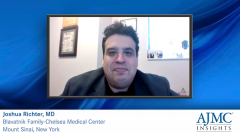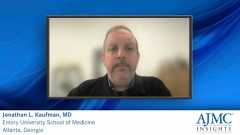
Using Lenalidomide and Pomalidomide in RRMM Management
Dr Richter explains which patients would benefit the most from using lenalidomide vs pomalidomide, while Dr Kaufman calls attention to clinical trials that support the use of pomalidomide in RRMM therapy.
Episodes in this series

Joshua Richter, MD: We have a litany of studies showing that when you’re on a lenalidomide-based regimen up front, you ought to remain on it until progression or intolerance. There may be some great drugs out there, but in a disease that is chronic and incurable, you want to milk every ounce of response out of every single drug until we have universal care for everyone. If someone is not tolerating the lenalidomide, don’t stop it; you can dose adjust, and that can mean going from 10 to 5 mg, or dosing every other day, or providing supportive care. Keep them on the drug if you can. It’s only when the patient truly progresses where you cannot manage the toxicity that you should move on to another line of therapy with a second-generation IMiD [immunomodulatory drug], such as pomalidomide.
The fact that lenalidomide is now generic will have several ramifications. Given the cost differential, there is a strong preference for some of the payers to utilize lenalidomide-based regimens. If you look nationally at the current rates, a triplet regimen in the United States—and triplets are the standard of care—ranges from around $350,000 to $550,000 a year, with the brand name IMiDs costing around $20,000 per month. They still have some of the best data and represent optimal strategies, so that’s not likely to impact things right now. However, there are ongoing studies seeking to optimize management in the early settings, and they are going to have to demonstrate not just a mildly superior efficacy improvement but factor in cost as well. Since lenalidomide induction regimens are set up to be cheaper, non–lenalidomide-based induction regimens have a higher bar to prove and supplant themselves firmly in the induction setting. However, I still think lenalidomide-based regimens are going to be the core of upfront and early relapse regimens in the United States in the near future.
Jonathan L. Kaufman, MD: There are multiple clinical trials looking at pomalidomide in relapsed/refractory myeloma. The most common regimens today are the combination of daratumumab, pomalidomide, and dexamethasone, as well as the combination of isatuximab, pomalidomide, and dexamethasone. Also, we have elotuzumab, pomalidomide, and dexamethasone; elotuzumab is the SLAMF7 inhibitor. We have bortezomib, pomalidomide, and dexamethasone, which somebody might consider if a patient is refractory to a CD38 monoclonal antibody. The strongest lines of evidence come from 2 large phase 3 studies. The first study is daratumumab, pomalidomide, dexamethasone vs pomalidomide, dexamethasone. Eighty percent of these patients were lenalidomide-refractory; about 10% of patients were at their first relapse. There is a significant increase in response rate with the combination and an increase in progression-free survival, from a median 6.9 months with pomalidomide, dexamethasone to 12.4 months for daratumumab, pomalidomide, and dexamethasone for a hazard ratio of 0.63, which is both clinically and statistically significant.
Similarly, isatuximab, pomalidomide, dexamethasone was compared to pomalidomide and dexamethasone. Under 10% of these patients were not lenalidomide-refractory, so the majority of these patients were lenalidomide-refractory. In this study, patients had had 2 prior lines of therapy. Again, median progression-free survival for the patients who were randomized to the pomalidomide and dexamethasone arm was 6.5 months, and the median progression-free survival for those randomized to isatuximab, pomalidomide, and dexamethasone was 11.5 months with a hazard ratio of 0.6, both a clinically and statistically significant improvement in outcomes. These 2 studies have confirmed the efficacy in the second- and third-line settings. There was an original study of daratumumab, pomalidomide, and dexamethasone, which led to its initial approval that was based on response rates in the refractory setting. The response rates are in the 70% range. In that setting, all patients in that study were refractory to lenalidomide.
This transcript has been edited for clarity.
Newsletter
Stay ahead of policy, cost, and value—subscribe to AJMC for expert insights at the intersection of clinical care and health economics.









































